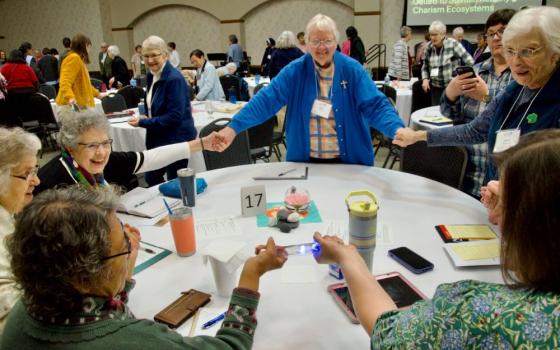On Friday, April 27, I began my review of Maura Jane Farrelly's new book Anti-Catholicism in America, 1620-1860, focusing on the ways anti-Catholicism shaped the political culture of England and its colonies in the 17th and early 18th centuries.
What is, for me, the most important part of the book is Farrelly's examination of how the stated concern of Whigs on both sides of the Atlantic to preserve "civil and religious liberties" was not a dual concern, but a single one, that the Whiggish conception of democracy grew forth from and seemed to demand a Protestant population. By the time of the American Revolution, these Whiggish ideas would be the air the patriots breathed.
"Increasingly through the seventeenth century, especially during the decades that followed the English Civil War, English-speaking Protestants came to believe that governments that respected an understanding of freedom that began with individual rights were 'godly' governments, and all other governments were hopelessly corrupt," Farrelly writes. She locates this conception of a government based on individual rights in Calvinistic understandings of freedom and in the individualistic approach to divine truth that was the immediate consequence of the Protestant Reformation.
The antithesis of a governmental system based on individual rights at the time was one that enshrined the divine right of kings. The king with whom the island nation and its colonies were most frequently at war was France and France was not only Catholic but it harbored the Catholic pretenders to the British throne who had been exiled by the Glorious Revolution. The colonists received anti-Catholicism as a kind of birthright of citizenship. Farrelly writes: "Fears of Catholicism — or what the colonists called 'popery' — played an important role in tipping the scales in America toward independence… The argument that 'the British government - the King, Lords, and Commons have laid a regular plan to enslave America' was asserted 'over, and over, and over again,' asserted one Connecticut loyalist."
The Quebec Act of 1774, which granted legal recognition to the Catholic Church in the Canadian province, was the source of much of the patriots' concern. When the revolutionary literature frets about the danger of being enslaved, the concern is not that the colonists would wake up black and working on a plantation in the South. The worry was that the British government was tending toward "popery."
Farrelly details the complete hypocrisy of the American Continental Congress which wrote to Canadians urging them to join the rebellion because the English promises of religious toleration could not be trusted, while also writing a letter to the people of Great Britain that warned the religious toleration of Catholics was a threat to English liberties. A Montreal printer published both documents together and the fraud was exposed. The letter to the people of Great Britain remains one of the high points of American anti-Catholicism, referring to the ancient faith as one that had "deluged your island in blood, and dispersed impiety, bigotry, persecution, murder, and rebellion, through every part of the world." The principal author of that document was John Jay, the future first Chief Justice of the United States and it was passed by the First Continental Congress in 1774.
Freedom, the opposite of slavery, is examined in the writings of the jurist William Blackstone, who exercised extensive influence on both sides of the Atlantic, and the religious roots of these conceptions. "For Protestants, freedom was something God gave to individual people so that each person could, on his or her own, read the Scriptures, confront the reality of sin, and choose to receive God's grace," she writes. It is not hard to see that once the fear of an angry God disappeared, and the latter two rationales for freedom were dropped, libertarianism would raise its ugly, distorting specter, but that is an intellectual trajectory for another time and another book. What is important here, as Farrelly notes, is how comprehensive the anti-Catholicism was in the revolutionary era. I will never again drink a Samuel Adams beer without thinking of his observation that Catholics, by "recognizing the pope in so absolute a manner … introduce as far as possible into the states, under whose protection they enjoy life, liberty, and property, that solecism in politicks, Imperium in imperio, leading directly to the worst anarchy and confusion, civil discord, war and bloodshed." Readers old enough to remember the 1960 election will recall that John Kennedy had not entirely shaken the Imperium in imperio charge, almost two hundred years after Adams penned those words.
Farrelly recapitulates the central result of her previous research, published in Papist Patriots, that Maryland Catholics were well disposed to the American Revolution in part because they had appealed to their own, native constitution in their fight to keep some of their freedoms, against Protestant efforts to introduce English penal laws. It is a fascinating point of historical irony.
Chapter 4, entitled, "The Catholic Religion is Modified by the Spirit of the Time in America," is the most uneven part of the book. She overstates the influence of Enlightenment ideals on the First Amendment's disestablishment clause. She notes that many states continued to have established religions on into the 19th century, but "on the national level, at least, most Americans at the dawn of the nineteenth century seemed willing to accept the premise of the Founders that the theological boundaries that separated one denomination — or even one religion — from another were unimportant when it came to the administration of good government." This underestimates the value attached to the sovereignty of the states, which was a central tenet, and overlooks the practical matter: which denomination to establish when Congregationalists predominated in New England, Anglicans in the South, Presbyterians in New Jersey and Quakers in Pennsylvania?
Similarly, her treatment of the relationship between the Vatican and the Catholic Church in the young republic is flawed, and not only by repeatedly referring to the" Propaganda de Fide," when there is no "de" in the name of that curial dicastery. Farrelly suggests that placing the American church under the Propaganda was an insult, "implying that America was something less than a free and independent country," and seeing such placement and the selection of an American bishop as an either/or relationship. In fact, the church in the U.S. did receive its first bishop in 1789 and remain under the supervision of Propaganda Fide until the early 20th century. Although she overstates Bishop John Carroll's commitment to lay trusteeism, her treatment of the subject is otherwise well done and concise.
Anti-Catholicism was muted and latent in the early years of the republic, but it never vanished and Farrelly returns to form in describing the interplay of anti-Catholic attitudes and Nativism in the early 19th century. It is always a bit startling to confront the fact that anti-Catholic literature built on easily falsifiable accounts about the "scandals of nunneries" were the best-selling books in American history at the time. Indeed, this part of the book makes the most fascinating reading at this moment in our nation's history. For example, she writes:
"Not all Nativists were conspiracy theorists like Simon Schmucker [who believed the pope had a plan to infiltrate America with immigrants]. Many people who worried about the impact that immigration would have on the political landscape in the United States felt that the pope didn't need to have an actual 'plan' in order for the Catholic Church to destroy democracy. Catholic voters would ruin things in America simply by failing to think for themselves as they cast their votes; they would ruin things simply by failing to be free."
Advertisement
I do not think anyone believes any longer that Catholics vote the way their priests tell them to, but the role of fear in shaping political opinions today is little changed from what it was then.
Farrelly's examination of the opinions of Orestes Brownson and the school question is magnificent and similarly involves issues that are still with us today. Protestants believed schools needed to train citizens to think for themselves. Catholics believed — and still believe — we must think with the church, sentire cum ecclesiae. The alternatives here are not freethinking libertarianism or slavery. The issue is whether a society can flourish unless people learn how to think together. Tradition, celebrated by Catholics and a source of suspicion for Protestants, is nothing more than the democracy of the dead, as Chesterton famously observed. If the premise of democracy is that no person should be denied her right to voice his opinion because of the accident of her birth, tradition asserts that no person should be denied her right to voice her opinion because of the accident of her death. The consequence for democracy of such a view is not necessarily slavery, but wisdom.
It was a great pleasure to read this book. Had I persisted in my graduate studies, this would have been the dissertation I wanted to write. I do not regret my decision to leave the academy, but I did regret not writing a dissertation about the role of anti-Catholicism in shaping the American Revolution. Farrelly's book does that and more, and fills a much needed hole in the previous historiography of the American nation. Brava!
[Michael Sean Winters covers the nexus of religion and politics for NCR.]
Editor's note: Don't miss out on Michael Sean Winters' latest: Sign up to receive free newsletters, and we'll notify you when he publishes new Distinctly Catholic columns.





